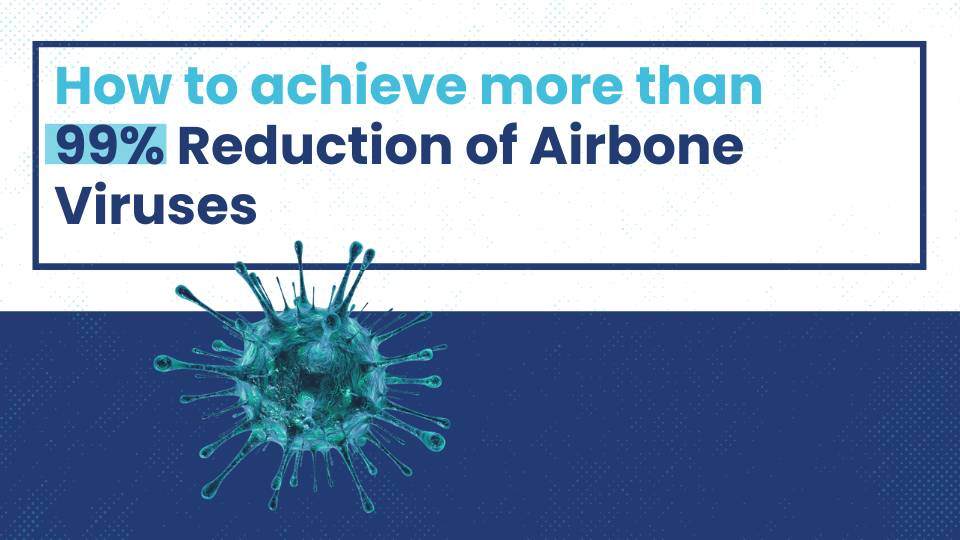Using Far-UVC to Improve Indoor Air Quality
Combatting Airborne Pathogens to Protect Health and Well-being
The power of UV light at 222 nm is unparalleled in its ability to eliminate harmful bacteria, viruses, and fungi in the air
Continuous Microbial Reduction in the Presence of People
Inactivation of airborne viruses up to 99.9%, including SARS-COV-2.
Air Changes Equivalents per hour (eACH)
Reduces spread of infection of colds, flu and other viruses. Read more.
Mercury-Free and Environmentally Friendly
Zero Mercury, no chemicals, 12 watt power consumption and UL867 Ozone Compliant. Read more.
Product Lifetime
Our technology exceeds the industry lifetime standards by more than 13.000 hours.
Efficient defense against airborne diseases
Airborne diseases constantly threaten public health, especially with the challenges posed by seasonal influenza and the current COVID-19 pandemic. Combat these risks effectively by enhancing indoor air quality with the installation of UV222.
This innovative technology works tirelessly to reduce the airborne bioburden, creating a safer environment for all.
The power of UV light at 222 nm is unparalleled in its ability to eliminate harmful bacteria, viruses, and fungi in the air. By proactively utilizing this germicidal effectiveness, you can take control of disease prevention and promote a healthier, safer space for everyone.
Trust in UV222 as a crucial tool in your defense against airborne diseases.

Enhancing Infection Control with Far-UVC Against Candida Auris
Our research underscores the power of Far-UVC technology as a game-changer in combating Candida auris, a pathogen posing significant challenges in healthcare facilities. The recent study confirms that Far-UVC light can inactivate 99% of Candida auris on various surfaces within 45 minutes, offering a robust solution that enhances hospital hygiene and reduces dependency on manual cleaning. This innovative technology effectively works on materials like steel, glass, and plastic, crucial for preventing the spread of an organism known for its alarming resistance to antifungal treatments and its ability to cause severe infections.
Combatting Mold with Advanced Far-UVC Solutions
Mold spores can compromise indoor air quality, triggering a range of health issues from severe allergic reactions to life-threatening infections, particularly in hospital environments. Our latest research reveals that intermittent, low-dose applications of UV222 are surprisingly effective in halting mold growth, ensuring cleaner air while maintaining safe environments for human presence. This innovative approach not only aligns with real-world usage but also opens new frontiers for maintaining health standards in medical facilities and beyond.
.jpg?width=800&height=600&name=Untitled%20design%20(88).jpg)
UV Medico Partners with Falck to Boost Ambulance Safety Using UV222 Technology
UV Medico has teamed up with Falck, a global leader in emergency services, to install UV222 Ambulance lamps in Falck's ambulances throughout Region Zealand in Denmark. This collaboration aims to revolutionize ambulance disinfection practices, significantly enhancing safety for both patients and healthcare workers.
Eliminate Airborne Viruses in Occupied Rooms Using Far-UVC Technology
A recent study published in Scientific Reports bridges the gap between laboratory benchtop studies and the real-world efficacy of Far-UVC light. The findings were nothing short of impressive: Far-UVC light reduced airborne infectious viruses by more than 99%

Latest Insights from UV Medico
1 min read
We Are Hiring: Sales Manager – Pharma & Life Science
Ping Hu: Oct 23, 2025
1 min read
We Are Hiring: Sales Manager – Hospitals (Europe)
Ping Hu: Oct 1, 2025
1 min read
We Are Hiring: Marketing Director
Ping Hu: Sep 30, 2025
 UV222™
UV222™ UV222 Linear
UV222 Linear UV222 Downlight
UV222 Downlight Vertex 222
Vertex 222.png) UV222 Pendant
UV222 Pendant.png) UV222 Booth
UV222 Booth.png) UV222 Step-On
UV222 Step-On.png) UV222 Cleanroom Downlight
UV222 Cleanroom Downlight UV222 Dual Downlight 60x60
UV222 Dual Downlight 60x60 UV222 Material Airlock
UV222 Material Airlock UV222 Ambulance
UV222 Ambulance UV222 Compact
UV222 Compact UV222 Industrial
UV222 Industrial